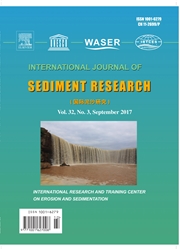

 中文摘要:
中文摘要:
地实验在 Diaoga 河里在床负担运输上被进行,在西南中国的一条山溪流,与改变沉积供应装载运输学习床的变化。床负担运输的率被到来的沉积(负担和尺寸) 极大地影响。在一样的流动条件下面,床负担运输率可以由取决于大小是否在一年的第一洪水前后被拿的三个数量级不同。床负担运输率对流动紧张的关系看起来有类似的特征作为一顺时针方向环等级曲线。实验也在非洪水季节期间被进行从在上游的节与不同到来的负担学习床负担运输过程。有不同尺寸的床负担能被组织进二种类型:旅行的床负担和结构的床负担。旅行的床负担比一种批评尺寸, Dc,和它的运输率主要取决于到来的沉积率的由好的沉积组成。到来的沉积率能由三个数量级改变床负担运输的率。结构的床负担由更粗糙的沉积组成,它的运输率仔细依靠流动紧张。
 英文摘要:
英文摘要:
Field experiments were conducted on bed load transport in the Diaoga River, a mountain stream in southwest China, to study the variation of bed load transport with varying sediment supply. The rate of bed load transport is greatly affected by incoming sediment (load and size). Under the same flow conditions, bed load transport rates may differ by three orders of magnitude depending on whether measurements were taken before or after the first flood of the year. The relation of the "bed load transport rate versus flow intensity" appears to have similar characteristics as a clockwise looped-rating curve. Experiments also were conducted during the non-flood season to study bed load transport processes with different incoming load from an upstream section. Bed load with different sizes can be grouped into two types: traveling bed load and structural bed load. Traveling bed load is composed of sediment finer than a critical size, De, and its transport rate depends mainly on the incoming sediment rate. The incoming sediment rate can alter the rate of bed load transport by three orders of magnitude. Structural bed load is composed of coarser sediment and its transport rate closely relies on the flow intensity.
 同期刊论文项目
同期刊论文项目
 同项目期刊论文
同项目期刊论文
 期刊信息
期刊信息
